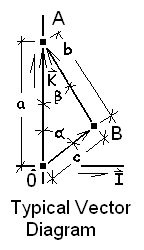| THERMO Spoken Here! ~ J. Pohl © | TOC NEXT ~ 11 |
Crank, Rod and Piston
 "Power trains" are the mechanical parts by which the power of combustion is transformed into power of a rotating shaft. A sketch of a simple crank-rod-piston arrangement is shown. Coordinates are introduced, below right.
"Power trains" are the mechanical parts by which the power of combustion is transformed into power of a rotating shaft. A sketch of a simple crank-rod-piston arrangement is shown. Coordinates are introduced, below right.
We identify the centerline of the crank as a stationary origin, notated 0 with one axis vertical and another horizontal from that origin. Let letters A and B identify locations of the piston and wrist pin (relative to the origin) respectively.
Engine designers must know the position of the piston face, represented by the vector 0A, for every position of the crank, represented by the vector 0B. A vector diagram representing the engine components is shown. The operating variables are the angles, α and β. The vector lengths are the variable length, a(t), and the constant lengths, b, and c.
Describe the geometry of the engine components with vectors. Reduce the vectors to obtain two
algebraic equations that relate the angles and lengths of the mechanism.
♦ We start with the truth expressed by this vector equation:

0A = 0B + BA
The truth of the above statement is obvious true for the position shown (and for all other positions). Next we write the above implicit equation, explicitly. We write vectors for which the length is known (and constant) in magnitude-direction form.
aK = [ c sinα I + c cosα K] + [ b sinβ (- I) + b cosβ K]
Confirm that this important equation is correct. Next combine the right-side I and K components.
a K = [ c sinα - b sinβ] I + [ c cosα + b cosβ ] K
As a extra step, let us rewrite the above equation to show its time dependence explicitly. This amounts to simply suffixing "(t)" to any symbol the values of which vary in time. The new equation is:
a(t) K = [ c sinα(t) - b sinβ(t)] I + [ c cosα(t) + b cosβ(t) ] K
The time-dependent variables a(t), α(t) and β(t) are made explicit. Time and much writing is saved by not writing the dependence, "( t )." That is by leaving the dependencies implicit.
To proceed (omitting time dependence) we scalar multiply this equation first by the unit vector I, then by K. The I - component multiplication yields, 0 = c sinα - b sinβ, which rearranges to be:
c sinα = b sinβ which is the Law of Sines:
sinα / b = sinβ / c
The K component multiplication yields: a = c cosα + b cosβ, or c cosα = (a - b cosβ)
Next, we take the I and K relations and square them:
I : (c sinα)2 = (b sinβ)2 and K: (c cosα)2 = ( a - b cosβ)2
Write these squares one above the other to add them:
c2 (sinα)2 = b2 (sinβ)2
c2(cosα)2 = a2 - 2ab (cosβ) + b2 (cosβ)2
With a touch of algebra the result is the Law of Cosines:
c2 = a2 - 2ab(cosβ) + b2
Students who have studied trigonometry (but not vectors) would have considered using these two laws. Some might remark, why bother with vectors? Vectors are powerful. Trigonometry is built into them. Also, if time dependence is introduced, as say α(t), the vector equations differentiate readily to yield relationships of velocities of the engine parts.